Daniel Ash – Multimedia Programme Coordinator
We locked eyes across the gap in the hot, humid canopy of the rainforest. Even at a distance, I could feel the power in this mighty bird’s eyes. I have waited many years for this moment; finally, it has come to fruition…
Our team arrived by Peque-Peque (a small surprisingly sturdy fishing boat) at midday on the dot into a small winding valley cut into the banks of clay by a tributary of the Alto Madre de Dios River in Peru. We boarded the soft sandy beach, walking approximately 50m upstream before having to take a sharp left turn into a slow muddy ascent into the hot humid rainforest.
Army ants swarmed the trail in droves, Juan Carlos (our guide and Diamante village elder) and I shared a laugh due to him having to keep slapping his feet and ankles due to only being in sandals. Ten minutes further and we arrived with Antonio (another village elder) exclaiming “mira!” (look!) as he first pointed out the huge goblet-like nest out in the thick jungle canopy. Nestled expertly between the thick ashen grey-white trunks of the Brazil nut tree. A testament to this large cumbersome-looking bird’s dexterity.
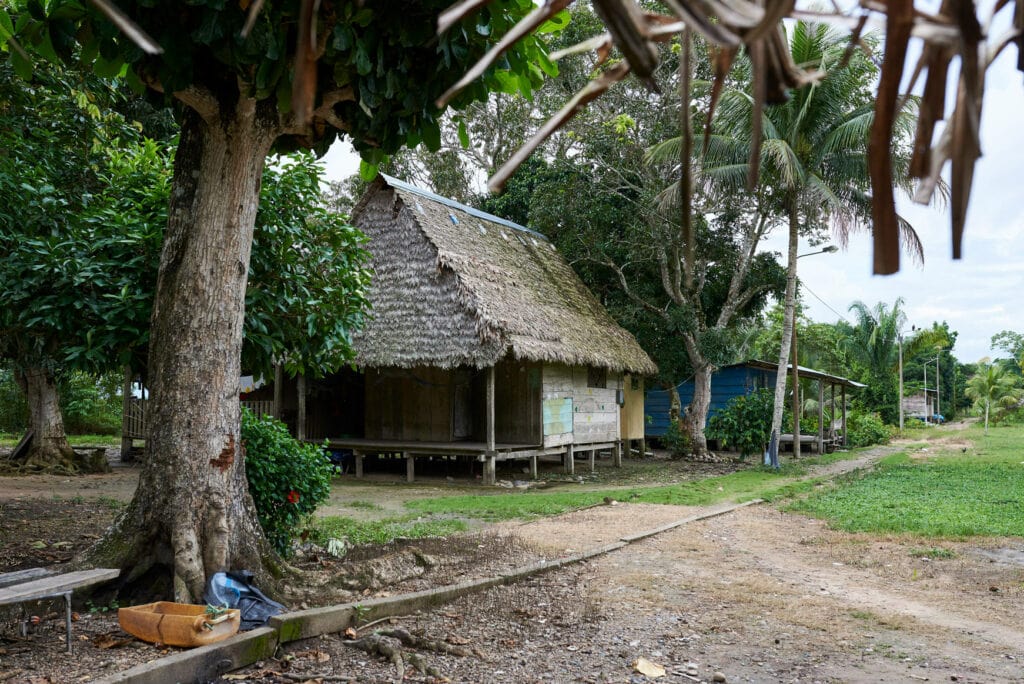
On first appearances, all we could see were some stray brilliant white head feathers poking out above the seemingly cataclysmic sticks and branches of the nest, on closer look you could see how expertly they had been weaved and placed to hold fort in the canopy. After some patience and a little waiting, the young scruffy awkward adolescent Harpy Eagle made a full appearance, spreading their wings in all their glory.
Already only a few months old, it was already an impressive size. Clearly taking all its parents’ attention to be fed and nurtured. Harpy eagles will usually have a clutch of 2 eggs however once one hatches, they will neglect/break the other to put all their focus into raising the one bird; a result of the high energy requirements for growth whilst still enabling them to provide for themselves, with the incubation period lasting for around 56 days.
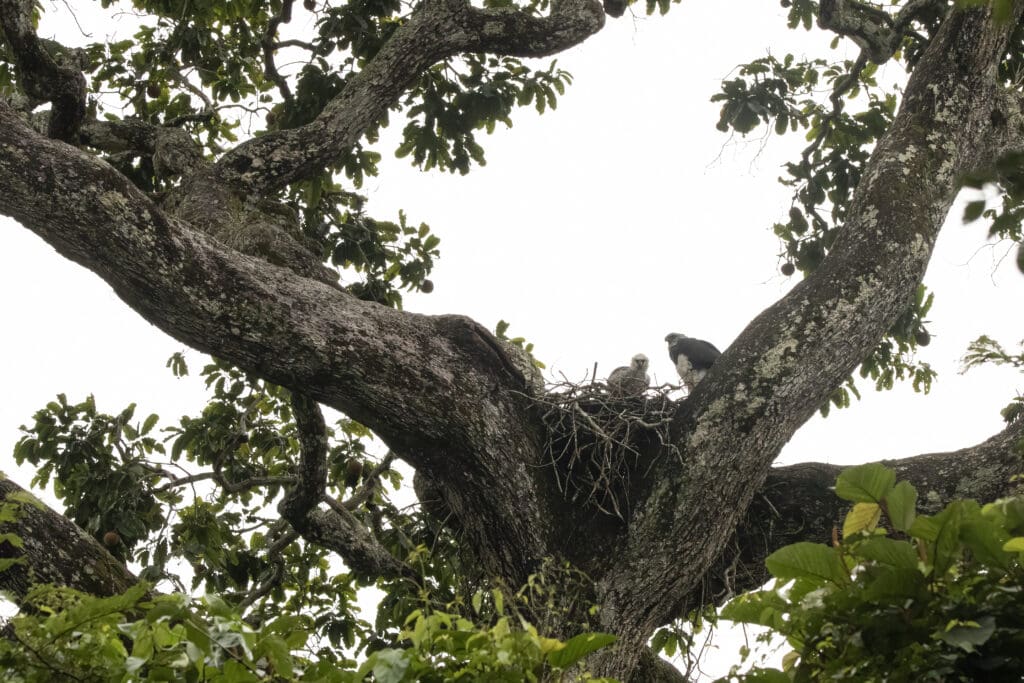
Catching us by surprise, the adult male swooped and landed majestically into the nest in spectacular fashion. Unfortunately without a meal for the chick this time. After acknowledging his child, he promptly hopped out the nest, perching on the trunk of the mighty Brazil nut tree. Sitting proudly whilst surveying his kingdom.
An incredible bird under persecution simply for its fearsome yet enchanting appearance, there are even legends in some parts of South America of harpy eagles (Harpia Harpyja) carrying off children to be devoured. No wonder this has led to local people killing these magnificent creatures. Apart from the aforementioned, there are a variety of additional reasons for these birds’ premature endings.
These include people shooting the birds purely out of curiosity, simply because they wish to see the birds up close, usually followed by feelings of remorse in most cases. Followed by the Eagles being perceived as a threat to livestock, even though it is extremely rare for them to take anything, similar to the persecution of birds of prey in the UK.
Other reasons can include hunger for bush meat or harvesting parts of their body, such as their huge talons – considered a symbol of power in some parts, even allegedly being used in baptism ceremonies for children. Their feathers are harvested for clothing, jewellery and for making arrows. Add on those who wish to keep them in captivity illegally and they have a whole host of problems to deal with; on top of surviving in one of the most unforgiving environments in the world.
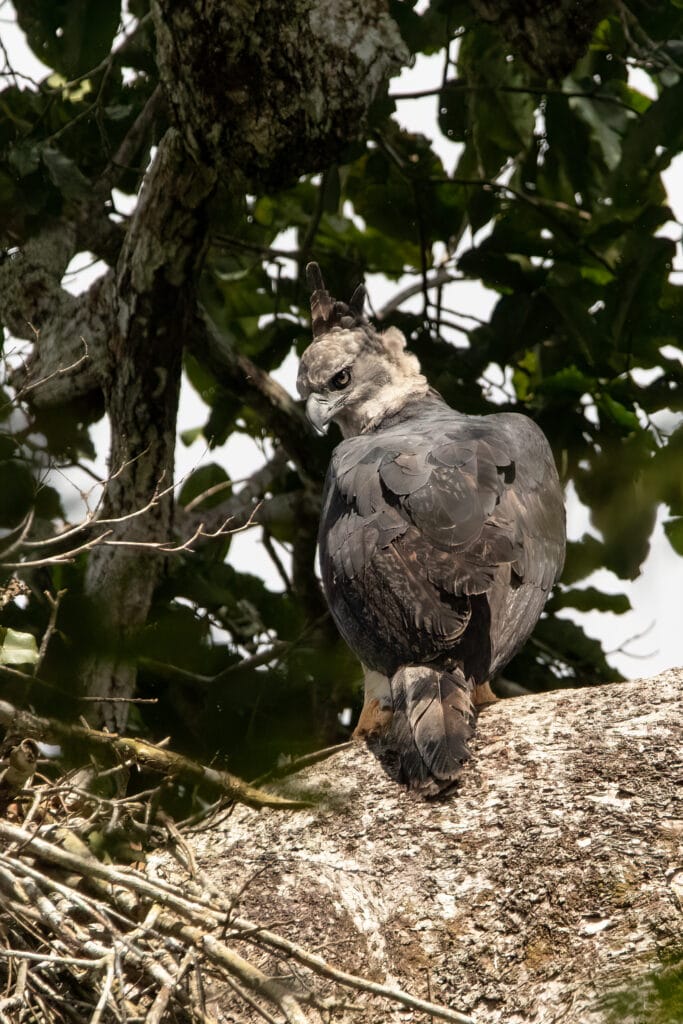
As elusive as they can be due to their habit of rarely soaring, preferring to fly from tree to tree, navigating the upper canopy. Their habit of hunting by spending long periods of time perched in larger trees waiting to strike is their downfall, giving any potential human threats plenty of time to react. There have been cases where the birds have spent over 24 hours in a singular tree, giving an opportunity for anyone who has spotted them a chance to return later on with their tools of devastation.
Naturally, they have a preference for the larger trees in the rainforest which can support their requirements for nesting sites. Trees such as the Brazil nut, Kapok or Shihuahuaco. With the latter forming an almost co-evolutionary relationship due to being able to provide the ideal site for their needs. Kapok trees can also have a special relationship with this bird, it is considered to be bad luck to cut down a Kapok tree in parts of South America, potentially having a positive effect in providing further protection, helping to conserve these wonderful birds.
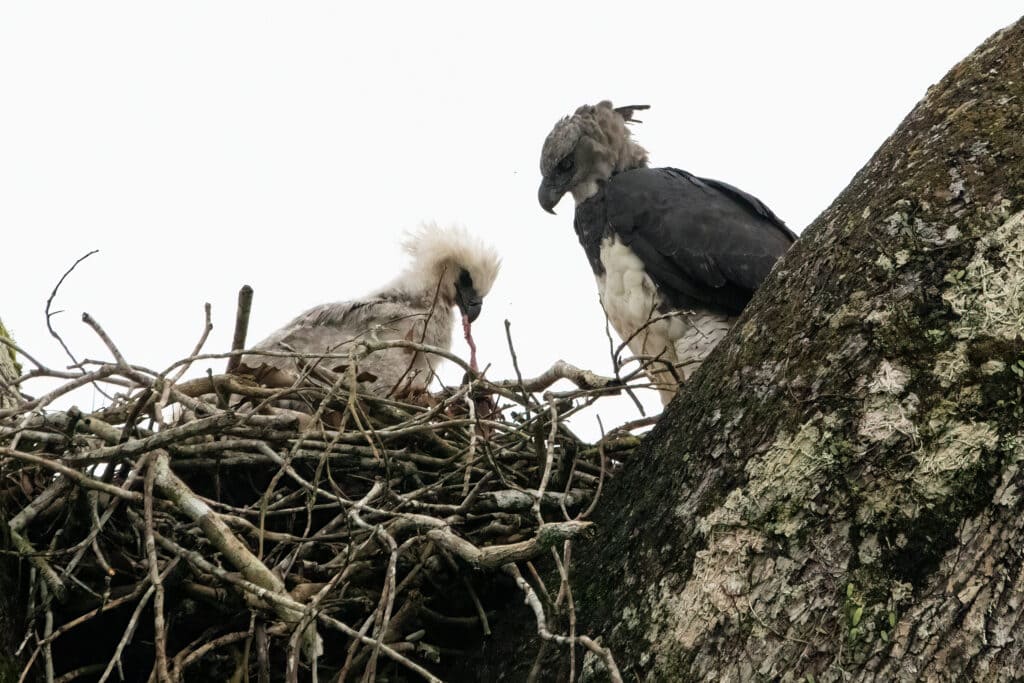
Their nests are so large that they can be as wide as 4-5ft in diameter and up to 3-4ft deep, evidently, this is the very first thing we noticed upon arrival at the site. Our local guide Antonio informed us that construction in this Brazil nut tree began in March. That the pair were taking branches from the adjacent Shihuahuaco tree. Why they chose the Brazil nut over the Shihuahuaco I am not sure. However, I have a few guesses and observations…
One reason being that the initial formation of the trunk was very wide and allowed a great initial starting “platform”. Secondly, the nest seemed to be in more of a “sun trap” which would allow for it to dry out faster after torrential rain and storms (more on that later). Protecting the chick from illness and reducing the need for as much maintenance by preventing mouldy wood and potential funghi. Third, being so close to another mighty tree provides them with a source of strong durable nesting material without over expending energy in the construction and maintenance processes. Harpy eagles can weigh between 4-9kg, a frame that requires a lot of energy intake as it is without having to provide for a growing chick.
Another observation was that clear flight paths were available on both sides into the nest, therefore ease of access was most likely another deciding factor combined with providing an excellent vantage point. There are probably more reasons at play than we can fathom; however, from these observations it shows that these eagles are no “bird brains” and have a high intelligence when it comes to choosing a base to navigate family survival in the jungle.
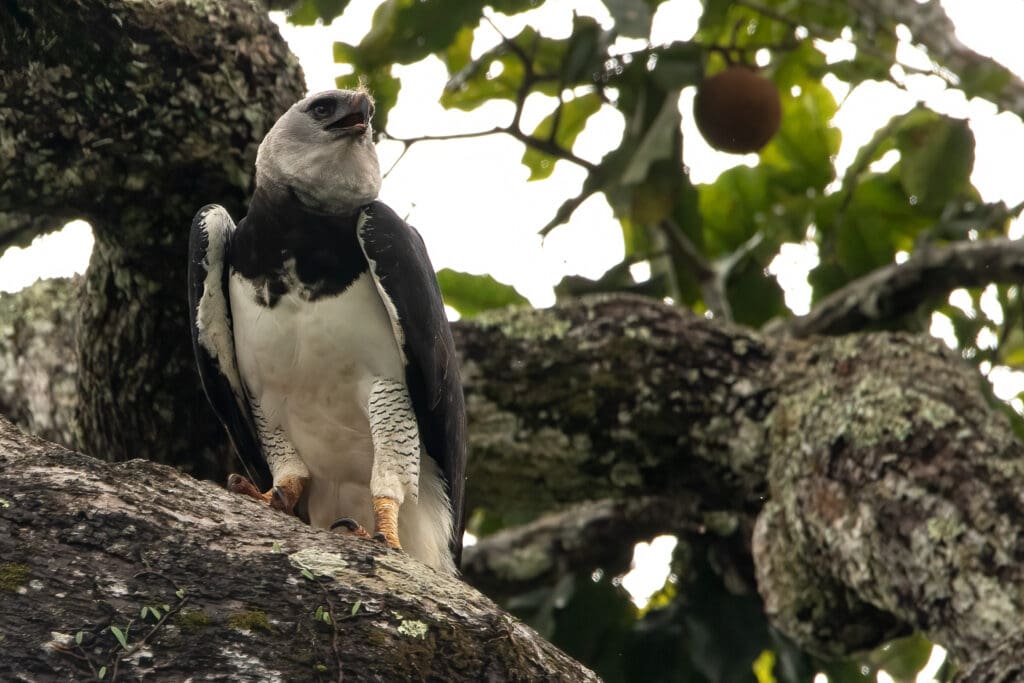
We were blessed with observing these wonderful creatures for a period of 3 hours from a distance. With no sign of the mother we decided to retire early due to the incoming menacing clouds and travel fatigue. Our worries and better judgement were confirmed, heavy rains hit our lodging at Diamante, not only rain but some of the loudest, most intimidating thunder and lightning we had ever seen or heard! Whilst attempting to sleep, you couldn’t help but wonder how the birds were faring…
An early alarm at 6am with a quick breakfast and we’re out into the fog, travelling by Peque-Peque once more, driven by Juan Carlos’ son, who’s control and expertise disguised his age of only 17 years. Arriving back at the nesting site just after 7, the foggy conditions still hounded us; thankfully there wasn’t much activity, only a solitary sleeping chick. Twenty minutes passed, the mist slowly dispersed with sporadic showings from the sun breaking through the overcast clouds.
Out of nowhere, suddenly graced by the presence of the beautiful mother bird, we watched as she glided gracefully into the nest. The chick looked hopefully up at their mother only to be disappointed yet again – having only retrieved a large branch in her powerful talons. Clearly to make repairs after a heavy and I imagine a tough night.
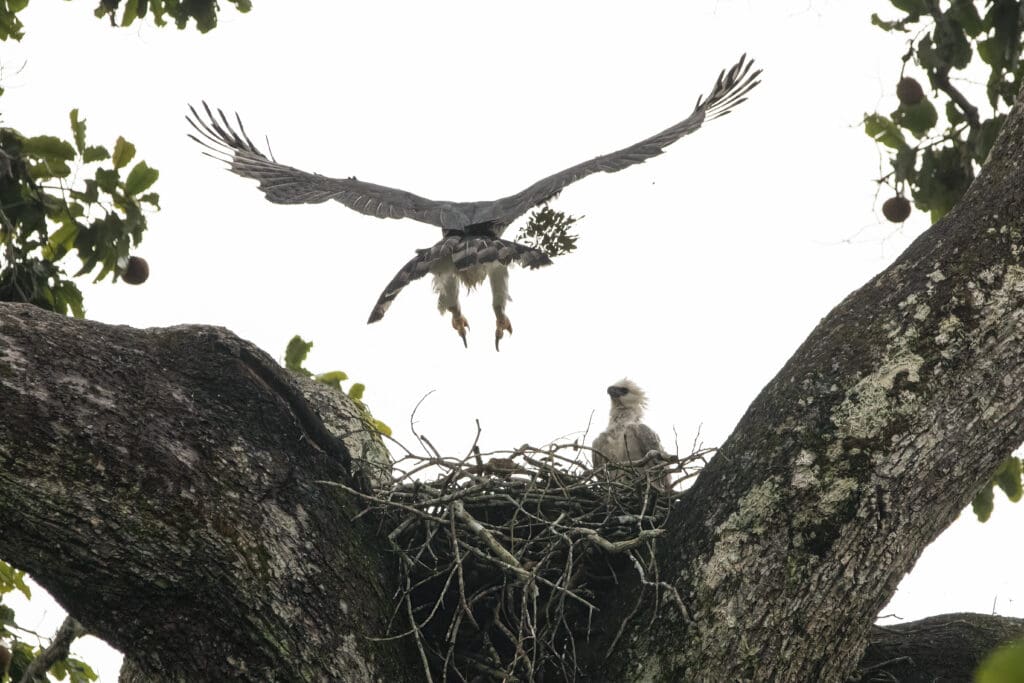
With maintenance finished, she flitted restlessly around the nest, jumping out, moving perch to perch on the trunks. Like most mothers, seemingly overwhelmed by the screeches from her hungry child, she began her own chorus, calling out desperately to her mate! You could feel the tension as her calls became less frequent over the course of a few hours…
After some time, out of the corner of his eye, one of our local guides spotted the male returning into the adjacent Shihuahuaco tree. This sent the mother and child into a frenzy, giving me the cue to start recording.
A short break to catch his breath, suddenly, the male burst into flight. Covering the 30m or so in seconds with a monkey like shape gripped in those fearsome talons by its head. Skilfully dropping the prey at the feet of his partner, she promptly took over to finish the job. Erupting into a concerto of ear piercing screams; giving a perfect example as to how they earned their name with the whole family joining in.
An incredible sight to see the mother exhibiting this behaviour as she prepared the food, making sure it was safe to pass on to her child. Meanwhile, the father having fulfilled his duty leapt out of the nest to clean his blood stained talons and beak – soon after leaping into action to soar over our heads to resume the hunt.
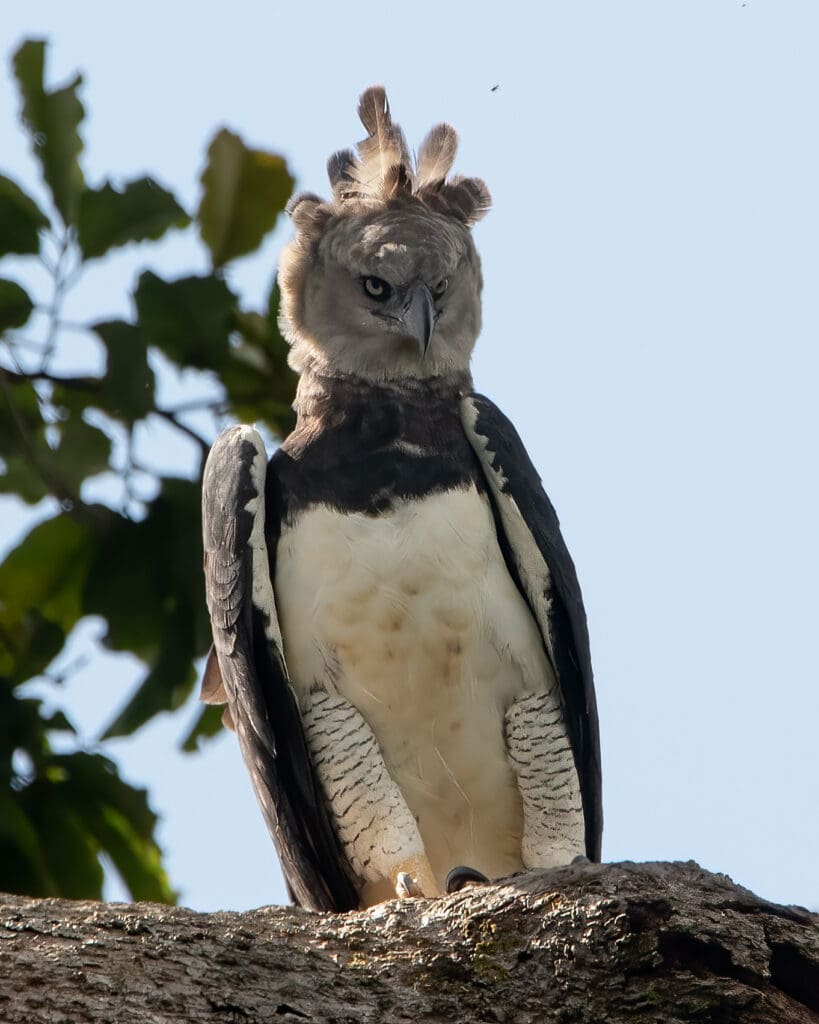
Another showcase of the teamwork exhibited by these incredible birds; strong bonds are formed due to them being characteristically monogamous with pair-bonds lasting for life (on average 25-35 years). In this time, collaborating to build nests, breeding once every 2-3 years expending their energy raising a solo chick. The chicks won’t fledge until 6 months, even after this time the parents continue to feed them for a further 6-10 months. Adults then reach breeding maturity after 4-6 years.
According to Birdlife international there are between 3,300-6,700 mature individuals in Peru, which sounds abundant yet numbers are falling dramatically. Their breeding habits are a contributing factor to their vulnerability, it is impossible for them to procreate fast enough to compensate for this dramatic loss in individuals.
The main threats to their population are habitat loss due to intensive agriculture/farming (specifically beef and soy farming due to land requirements), with additional demands for land due to the expansion of cattle ranching, logging and prospecting. Overall as a species they have near threatened status, with a vulnerable status here in Peru. They have almost been wiped out in Brazil, only being found in the remotest parts of the Amazon!
To combat this, schemes are becoming more commonplace, working in conjunction with local people and landowners to preserve nesting sites for the purpose of eco-tourism. Some projects offer up to $100 to local people for each nest discovered, also having locals build viewing platforms at a suitable distance so that the birds can be seen at eye-level respecting their need for space.
On average $20 can be earned for each tourist per day, which has a beneficial knock-on effect to incentivise conserving habitat which in turn works out to benefit other species within the area. In some cases land-owners can sign an agreement to protect 320 hectares of forest surrounding the nest.
After a productive morning with these magnificent creatures, unfortunately our time had to end. The male may not have returned whilst we were there however we were left with memories that will stay for a lifetime!
For more information please contact info@crees-manu.org to arrange any kind of Manu trip with the Harpy eagle activity
www.danielashphotography.co.uk
Instagram: danielashphoto
Read more: https://www.crees-manu.org/blog/


